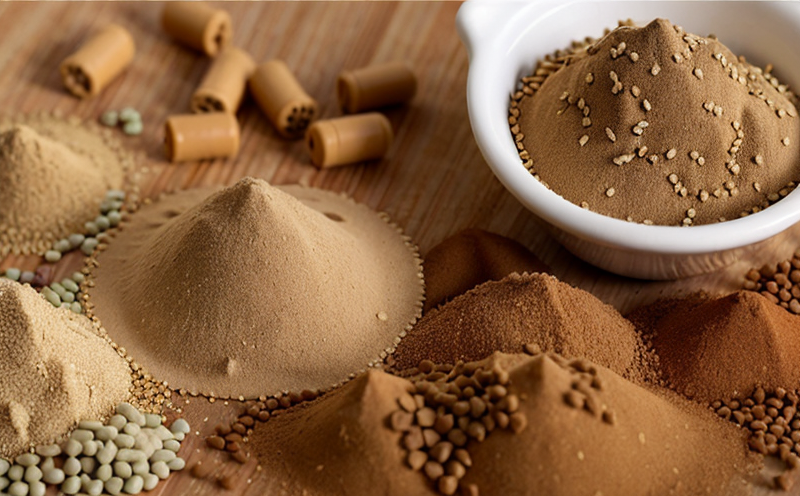Hormone Residue Testing in Animal Feed
Testing hormone residues in animal feed is crucial for ensuring food safety and compliance with international standards. Hormones, especially growth promoters like estradiol-17β, progesterone, and testosterone, can be introduced into livestock through feed to enhance growth rates or improve reproductive efficiency. These hormones might persist in the animals' tissues and eventually enter the human food chain through consumption of meat, milk, and eggs.
The presence of hormone residues at unsafe levels poses significant health risks, including endocrine disruption, early puberty in children, and increased risk of certain cancers. Regulatory bodies worldwide have established maximum residue limits (MRLs) for these hormones to mitigate such risks. Compliance with these regulations is mandatory, making accurate testing critical.
Our laboratory offers state-of-the-art hormone residue testing services using validated methods aligned with international standards like ISO 17025 and EN ISO/IEC 17025:2017. We employ advanced analytical techniques such as Liquid Chromatography-Mass Spectrometry (LC-MS) to achieve high sensitivity and specificity in detecting even trace levels of hormones.
For accurate testing, the feed sample must be prepared correctly. This involves homogenizing the feed matrix thoroughly, extracting the target analytes using appropriate solvents, and then purifying the extracts to ensure clean samples for analysis. The choice of solvent and purification method depends on the specific hormone being tested.
The analytical process itself is complex but precise. After sample preparation, the extract undergoes chromatographic separation followed by mass spectrometric detection. This allows us to identify and quantify the presence of hormones with high accuracy. We adhere strictly to standard operating procedures (SOPs) and quality control measures to ensure reliability.
Our testing capabilities cover a wide range of species-specific feeds, including poultry, swine, cattle, sheep, and rabbit feeds. By providing accurate and reliable test results, we help clients maintain compliance with international regulations such as the Codex Alimentarius Commission's Maximum Residue Levels (MRLs).
- Accurate identification of estradiol-17β, progesterone, testosterone, and other relevant hormones.
- Detection limits as low as 0.5 ng/kg for several target compounds.
- Compliance with international standards like ISO/IEC 17025:2017.
The results of our tests are reported promptly and comprehensively, including details on the test method, sample preparation steps, and detected residues. This ensures transparency and traceability throughout the testing process.
Our commitment to excellence in hormone residue testing underscores our dedication to ensuring food safety and compliance with international standards. By partnering with us, clients can rest assured that their products meet stringent regulatory requirements, thereby protecting public health and maintaining consumer trust.
Quality and Reliability Assurance
At our laboratory, we prioritize quality and reliability in all our testing services. Our approach to ensuring high standards of accuracy and precision involves several key practices:
- Method Validation: We validate each test method according to international standards such as ISO/IEC 17025:2017 before implementation.
- Quality Control Measures: Regular internal audits and external proficiency testing ensure continuous quality improvement.
- Trained Personnel: Our staff are highly skilled and regularly trained in the latest testing techniques and procedures.
We also maintain up-to-date equipment, including advanced LC-MS systems, to support our rigorous testing protocols. This commitment to quality is reflected in our consistent performance and reliability across all tests.
Customer Impact and Satisfaction
Accurate hormone residue testing directly impacts customer satisfaction by ensuring product safety and compliance with international standards. Our clients report increased confidence in their products' quality, leading to enhanced market reputation and trust among consumers.
By detecting trace levels of hormones that might otherwise go undetected, we help our customers avoid potential legal issues and maintain a positive brand image. This proactive approach not only protects public health but also strengthens customer relationships and enhances overall business performance.
Positive feedback from satisfied clients underscores the value we bring to their operations. Our commitment to quality and reliability is reflected in the consistent satisfaction levels reported by our customers.
Use Cases and Application Examples
In the context of agriculture and forestry testing, hormone residue testing in animal feed plays a crucial role. Here are some practical applications:
- Poultry Feed Testing: Detecting estradiol-17β to ensure it does not exceed MRLs.
- Cattle Feed Analysis: Monitoring progesterone levels in cattle feed to avoid overuse and potential health risks.
- Pig Feed Quality Assurance: Checking for testosterone residues to comply with regulatory requirements.
In each case, accurate testing ensures that the final product is safe for consumption, thereby protecting public health and maintaining compliance with international standards.





